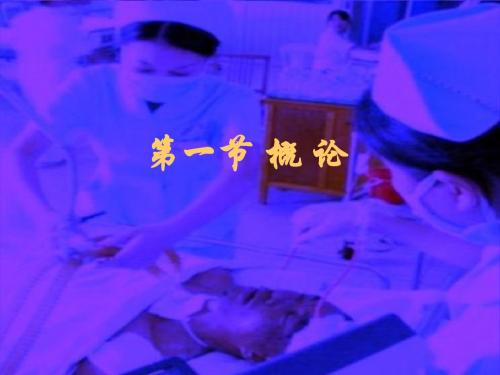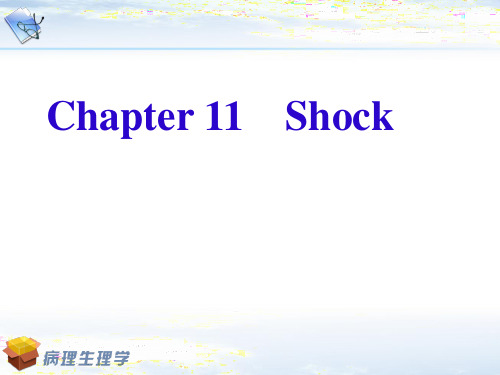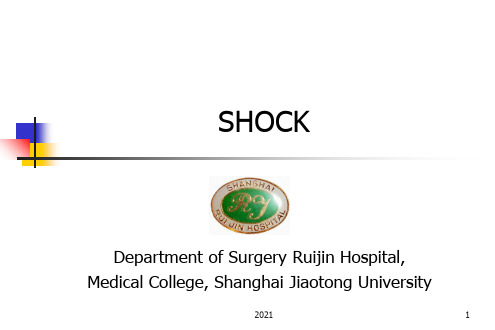英文医学课件:休克课件
合集下载
外科休克ppt精品医学课件

(三)休克介质
儿 茶 酚 胺 (Catecholamine)
肾素-血管紧张素系 统(RAS)
血 管 加 压 素 (vasopression)
激肽(kinins)
花生四烯酸产物
前列环素(PGI2)
血栓素A2(TXA2)
白三烯(LTs) 内啡肽(endorphin) 氧自由基 肿瘤坏死因子(TNF) IL-1 ICAM-1 一氧化氮(NO)
真菌、病毒、原虫感染也是感染性休克 的原因
致病菌往往非单一的 感染源:多由于肺、腹部、尿道感染 医源性血管内装置引起感染↑
2.病理生理
免疫学的双向反应: 先是压倒性的炎症反应, 然后是免疫抑制反应
免疫源
G-:甲酰多肽、内毒素、蛋白酶、外毒 素
G+:外毒素、 肠毒素、溶血素
免疫细胞
巨噬细胞 单核细胞 白细胞(如中性粒细胞) T细胞
微循环障碍 细胞代谢障碍 休克介质 脏器的继发改变
(一)微循环的变化
收缩期 扩张期(休克抑制期) 衰竭期(DIC)
微循环障碍
◆
休克早期(缺血缺氧期)
病因
多种缩血管体液因素(儿茶酚胺、肾
素 - 血 管 紧 张 素 、 醛 固 酮 、 血 栓 素 A2、
血小板活化因子、白三烯、内皮素等)
微血管强烈痉挛 微循环灌注减少
免疫反应:
免疫源与免疫细胞受体结合并激活调节 蛋白(如转录调节因子NK-κB),促进细 胞因子的产生。
炎症介质可以激活内皮细胞、血管平滑 肌细胞、巨噬细胞产生一氧化氮( NO), NO既可以介导休克时的血管收缩,也可 以介导休克时的心肌抑制和小肠通透性 增加。
炎症介质还可以内皮细胞和中性粒细胞 的细胞粘附分子表达增加,这一切加剧 了免疫反应和休克时的损伤;
休克ppt课件

休克ppt课件
CATALOGUE
目 录
• 休克概述 • 休克的原因 • 休克的治疗 • 休克的预防 • 休克与多器官功能障碍综合征(
MODS) • 休克的临床表现及处理流程
01
CATALOGUE
休克概述
休克的定义
休克是一种急性循环障碍综合征,通常由大量失血、失液、 严重创伤、感染、过敏反应等导致,使机体循环功能急剧下 降,组织器官灌注不足,进而引起全身性生理功能紊乱和代 谢障碍。
休克的症状
休克的症状包括血压下降、心 率加快、呼吸急促、意识模糊 、皮肤湿冷、口唇发绀等。
随着病情加重,患者可能出现 多器官功能衰竭、酸碱平衡紊 乱、电解质失衡等症状。
休克对机体的影响因病因和严 重程度而异,治疗方法和预后 也有所不同。
02
CATALOGUE
休克的原因
失血性休克
总结词
因大量失血引起的休克,称为失血性休克。
ቤተ መጻሕፍቲ ባይዱ
提高对休克的认知和警惕性
了解休克的症状
了解休克的症状,如头晕、乏 力、出汗、心慌等,以便及时
发现和处理。
学习急救知识
学习基本的急救知识,如心肺 复苏、止血等,以便在紧急情 况下能够自救或救助他人。
注意身体状况
密切关注自己的身体状况,如 有异常症状应及时就医。
避免危险因素
避免接触和吸入有害物质,如 化学气体、病毒等,以减少休
胞凋亡等多个方面。
休克与MODS的关系
休克与MODS的关联
休克是MODS的重要诱因之一,也是MODS发展过程中常见的临 床并发症。
休克对器官功能的影响
休克时,全身血流灌注不足,各器官功能受损,尤其是对心、肺、 肾等重要器官的影响更为显著。
CATALOGUE
目 录
• 休克概述 • 休克的原因 • 休克的治疗 • 休克的预防 • 休克与多器官功能障碍综合征(
MODS) • 休克的临床表现及处理流程
01
CATALOGUE
休克概述
休克的定义
休克是一种急性循环障碍综合征,通常由大量失血、失液、 严重创伤、感染、过敏反应等导致,使机体循环功能急剧下 降,组织器官灌注不足,进而引起全身性生理功能紊乱和代 谢障碍。
休克的症状
休克的症状包括血压下降、心 率加快、呼吸急促、意识模糊 、皮肤湿冷、口唇发绀等。
随着病情加重,患者可能出现 多器官功能衰竭、酸碱平衡紊 乱、电解质失衡等症状。
休克对机体的影响因病因和严 重程度而异,治疗方法和预后 也有所不同。
02
CATALOGUE
休克的原因
失血性休克
总结词
因大量失血引起的休克,称为失血性休克。
ቤተ መጻሕፍቲ ባይዱ
提高对休克的认知和警惕性
了解休克的症状
了解休克的症状,如头晕、乏 力、出汗、心慌等,以便及时
发现和处理。
学习急救知识
学习基本的急救知识,如心肺 复苏、止血等,以便在紧急情 况下能够自救或救助他人。
注意身体状况
密切关注自己的身体状况,如 有异常症状应及时就医。
避免危险因素
避免接触和吸入有害物质,如 化学气体、病毒等,以减少休
胞凋亡等多个方面。
休克与MODS的关系
休克与MODS的关联
休克是MODS的重要诱因之一,也是MODS发展过程中常见的临 床并发症。
休克对器官功能的影响
休克时,全身血流灌注不足,各器官功能受损,尤其是对心、肺、 肾等重要器官的影响更为显著。
休克(shock)课件

5.尿量
(二)特殊监测
1.中心静脉压(CVP)
代表了右心房或者胸腔段腔静脉内压力的变化。
CVP的正常值为5—10cmH20,当CVP< 5cmH20时, 表示血容量不足;高于15cmH20时,则提示心功能 不全、静脉血管床过度收缩或肺循环阻力增高; CVP>20cmH20时,表示存在充血性心力衰竭
微循环衰竭期,又称不可逆 期、DIC期
休克时体液的改变: 产生大量炎性因子
⑴儿茶酚胺 ⑵血管紧张素 ⑶激肽、缓激肽 ⑷组胺、5-羟色胺 ⑸啡肽和内啡肽 ⑹花生四烯酸代谢产物
(7)肿瘤坏死因子(TNF)和白介素 (8)休克毒素
(9)其它:补体碎片、血小板活化因子 (PAF)、一氧化氮、氧自由基;血栓素 (TXA2)、前列腺素(PGI)
2.肺毛细血管楔压(PCWP)
反映肺静脉、左心房和左心室压 正常值为6-15mmHg
PCWP低于正常值反映血容量不足;增高常见 于肺循环阻力增高如肺水肿
3.心排出量(CO)和心脏指数(CI) CO是心率和每搏排出量的乘积,正常值为4- 6L/min;单位体表面积上的心排出量称心脏 指数(CI),正常值为2.5—3.5L/(Min.m2) 混合静脉血氧饱和度 0.75
第一次世界大战Carnon和Bayliss测定了发 生在休克病人的生化、生理学变化,推测产生损 伤→全身反应是毒素作用→血管张力↓,静脉内 血液潴留、血压↓,提出“毒素学说”。对外伤 治疗采用→放血、截肢治疗。
1930年Alfred经典实验使“低血容量是外伤 性休克主要致病机制”的概念确定。 朝鲜、越战的休克研究更加注重复苏、单个 器官的功能障碍和细胞功能系统的研究。
(二)代谢变化
无氧酵解增加导致 1.乳酸增加 2.能量生成减少
(二)特殊监测
1.中心静脉压(CVP)
代表了右心房或者胸腔段腔静脉内压力的变化。
CVP的正常值为5—10cmH20,当CVP< 5cmH20时, 表示血容量不足;高于15cmH20时,则提示心功能 不全、静脉血管床过度收缩或肺循环阻力增高; CVP>20cmH20时,表示存在充血性心力衰竭
微循环衰竭期,又称不可逆 期、DIC期
休克时体液的改变: 产生大量炎性因子
⑴儿茶酚胺 ⑵血管紧张素 ⑶激肽、缓激肽 ⑷组胺、5-羟色胺 ⑸啡肽和内啡肽 ⑹花生四烯酸代谢产物
(7)肿瘤坏死因子(TNF)和白介素 (8)休克毒素
(9)其它:补体碎片、血小板活化因子 (PAF)、一氧化氮、氧自由基;血栓素 (TXA2)、前列腺素(PGI)
2.肺毛细血管楔压(PCWP)
反映肺静脉、左心房和左心室压 正常值为6-15mmHg
PCWP低于正常值反映血容量不足;增高常见 于肺循环阻力增高如肺水肿
3.心排出量(CO)和心脏指数(CI) CO是心率和每搏排出量的乘积,正常值为4- 6L/min;单位体表面积上的心排出量称心脏 指数(CI),正常值为2.5—3.5L/(Min.m2) 混合静脉血氧饱和度 0.75
第一次世界大战Carnon和Bayliss测定了发 生在休克病人的生化、生理学变化,推测产生损 伤→全身反应是毒素作用→血管张力↓,静脉内 血液潴留、血压↓,提出“毒素学说”。对外伤 治疗采用→放血、截肢治疗。
1930年Alfred经典实验使“低血容量是外伤 性休克主要致病机制”的概念确定。 朝鲜、越战的休克研究更加注重复苏、单个 器官的功能障碍和细胞功能系统的研究。
(二)代谢变化
无氧酵解增加导致 1.乳酸增加 2.能量生成减少
休克ppt英文版

causes → acute circulatory failure → microcirculation disturbance → ECBV(effective circulatory blood volume) ↓→ “low flow state” in vital organs → abnormal cellular metabolism and function, tissue injury, dysfunction of vital organs → shock
I. Concept of Shock
Lartin
General Critical Reaction: strike and vibration
1731, Henri Francois Le Dran apply to medicine for the first time
I. Concept of Shock
Regardless of causes, shock is defined as a clinical condition and pathophysiologic process characterized by microcirculation dysfunction( inadequate blood flow vital organs, and inability of cell to metabolize normally).
1.Description of symptoms & signs
“shock syndrome”
pale face cyanosis cold and clammy limbs oliguria faint consciousness hypotension
I. Concept of Shock
Lartin
General Critical Reaction: strike and vibration
1731, Henri Francois Le Dran apply to medicine for the first time
I. Concept of Shock
Regardless of causes, shock is defined as a clinical condition and pathophysiologic process characterized by microcirculation dysfunction( inadequate blood flow vital organs, and inability of cell to metabolize normally).
1.Description of symptoms & signs
“shock syndrome”
pale face cyanosis cold and clammy limbs oliguria faint consciousness hypotension
动物医学-病理生理学《休克》课件

三、按血流动力学特点分类
(Classification of shock by hemodynamic characteristics)
类型
特点
高排低阻型休克 (暖休克)
低排高阻型休克 (冷休克)
低排低阻型休克
心输出量↑,外周阻力 ↓,BP ↓,脉压差↑
心输出量↓,外周阻 力↑,脉压差↓↓
心输出量↓,外周阻 力↓ ,BP ↓↓
循环衰竭 升压药无效 脉搏细速、中心静脉压↓、静脉塌陷
毛细血管无复流 补液无效 重要器官和功能障碍、衰竭
第三节 休克中的细胞代谢、 结构改变和器官功能障碍
(Alterations of cellar metabolism and structure and impairment of organic function)
直捷通路 动静脉短路 真毛细血管通路
真毛细血管通路开放和关闭的调节
❖神经因素: 交感神经兴奋→关闭 ❖体液因素: 缩血管: CA, ET, AngⅡ等
扩血管: 乳酸、组胺、激肽等
Cap灌流的局部反馈调节
局部代谢 产物聚积
真Cap网 血流↓
Cap前括约肌 与后微A收缩
平滑肌对缩血管 物质反应性↓
二、按休克始动环节分类
(Classification of shock by initial changes)
烧伤
失血 失液
过敏 感染 神经源性
心源性
血容量↓ 血管床容积↑ 心输出量↓↓
有 效 循 环 血 量
组 织 灌 流 量
↓
↓
休克发生起始环节和共同基础
❖ 低血容量性休克 (Hypovolemic shock)
第二节 休克微循环障碍的机制
休克-英语解读PPT课件

2021
7
II. Definition of shock
A syndrome that results from inadequate perfusion of tissues
insufficient to meet metabolic demand
lead to cellular dysfunction, elaboration of inflammatory mediators, and celluar injury
2021
6
Controversy on Lung & Kidney
ARDS
Introduction of the flow directed pulmonary artery catheter, in 1970
Noncardiogenic nature
Not due to volume overload
→ improvement
Hypovolemia
Eastern
邪毒内陷 气随血脱 阴亏气脱 气机郁闭 阴绝阳脱
2021
3
with the Rise of Physiology
Burgeoning of Cardiovascular physiology in the end of 19CN, Crile
aggregation, other intraluminal debris
preventing RBC from reaching the tissues
extrinsic obstruction of cap. Bed
local tissue inflammation, edema, or hemorrhage,lmonary embolism
- 1、下载文档前请自行甄别文档内容的完整性,平台不提供额外的编辑、内容补充、找答案等附加服务。
- 2、"仅部分预览"的文档,不可在线预览部分如存在完整性等问题,可反馈申请退款(可完整预览的文档不适用该条件!)。
- 3、如文档侵犯您的权益,请联系客服反馈,我们会尽快为您处理(人工客服工作时间:9:00-18:30)。
What is “SHOCK” ?
n ջظฎݱᐿܻࢩ᩸ํපሾᤅᰁٺ̵ᕟᕢᅆ ဳӧ᪃̵ᕡᙱդᨀᔯԤۑᚆݑഖጱየቘኞቘᬦᑕ̶
ҁӾ܅տ᯿ዩ܅ړտܖ҂
n Shock is defined as acute circulatory failure, a situation in which the circulation fails to provide cells with sufficient oxygen to be able to perform optimally.
Farewell.
In the ICU
n Shock is affecting about 30% patients in the ICU who were assigned to receive either dopamine or norepinephrine
n septic shock occurred in 62% n cardiogenic shock in 16% n hypovolemic shock in 16% n distributive shock in 4% n obstructive shock in 2%.
Obstructive Distributive
Hemorrhage҅Trauma Dehydration
Myocardial infarction Cardiomyopathy Valvular disease
Severe arrhythmias Pulmonary embolism
Tamponade Aortic dissection Inflammatory response (mediators)
n Tissue hypoperfusion-the three “windows” of the body:
n cutaneous (skin that is cold and clammy) n renal (urine output of<0.5ml/kg/h) n neurologic (altered mental state includes obtundation, disorientation, and
n the key early contributor was Dr. Max Harry Weil
n Died of prostate cancer July 29,2011 at his home. n “He believed very strongly that we should be able to save more lives, that's what he
SHOCK
My Heart Will Go On
3
Young Men vs. Middle-aged Gentleman
James Roy Horner (14th, Aug, 1953҆22nd, Jun, 2015)
5
Once someone were sent into ICU, it may be a real
Severe arrhythmias Pulmonary embolism
Tamponade Aortic dissection Inflammatory response
(mediators)
Distributive Shock
Vasodilation
Cardiogenic Shock
Ventricular failure
Hypovolemic Shock
Loss of plasma or blood volume
Obstructive Shock
Obstruction
Pericardial tamponade
Pathophysiological type Hypovolemic Cardiogenic
Obstructive
Distributive
Cause
Hemorrhage҅Trauma Dehydration
Myocardial infarction Cardiomyopathy Valvular disease
n In 1827 English surgeon, George Guthrie first used the word “shock” in association with a physiological response to injury
n Dr. Thomas Latta in 1831- intravenous fluids for Hypovolemia
was working his whole life to do."
Classification of Shock
The four pathophysiological types of shock & principal causes
Pathophysiologicovolemic Cardiogenic
confusion).
n Hyperlactatemia
n the level >1.5mmol/l in acute circulatory failure.
Historical Story
n The word ‘shock’--French surgeon Henri LeDran; ‘choc’ in the English translation--”Shock”; ܾዩ
Introduction
n Diagnosis of shock is based on:
n Shock can broadly be summarized into three components:
n Systemic arterial hypotension in adults:
n the SBP<90mmHg n the MAP<70mmHg, with associated tachycardia.
